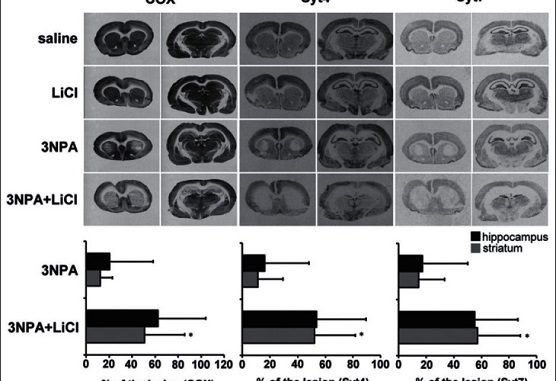
Lithium chloride has been used for more than 100 years to alleviate manic and depressive disorders. It is successfully used to alleviate the symptoms of bipolar disorders of schizophrenia and depression. Clinical studies and research in animal models have shown that lithium reduces damage to nervous tissue caused by many toxins. It was found that neuroprotective effects of lithium are due to the increased release of neurotrophic factors as well as the reduction of inflammation and oxidative stress. However, lithium in higher doses may also be neurotoxic.
The 3-nitropropionic acid (3-NPA) toxin is produced by certain types of fungi and plants. 3-NPA is often present in legumes, which is used for feeding grazing livestock. The moldy sugarcane poisoning by 3-NPA occurred in China with the ingestion of the sugarcane infested with Arthrinium gluten in the Aspergillus mold. It can also be found in soy sauce, Japanese spicy mussels made from fermented soybeans, barley or rice, mixed with salt and in some preparations in the Chinese traditional medicine. Symptoms of the 3-NPA intoxication are similar to motion disorders seen in Huntington’s disease (HD).
HD is an incurable hereditary disorder that results in death of brain cells. It occurs between the age of 35 and 40, and rarely before the age of 20. HD is characterized by intense uncontrolled movements of the body, jerking, weakening of the muscles and, consequently, stiff posture and unstable walking, followed by a decline in mental abilities, and the emotional disorder. HD is caused by a dominant mutation in the Huntingtin (HTT) gene on chromosome 4, which codes for the Huntingtin protein. The Huntingtin protein prevents programmed cell death and controls the production of brain-derived neurotrophic factor (BDNF).
3-NPA imitates the cell death process, which selectively occurs in the brain region called the striatum. The striatum is involved in movement and in the reward system. 3-NPA inhibits the mitochondrial enzyme succinate dehydrogenase (SDH) and prevents cellular respiration leading to cell death. The 3-NPA poisoning is suitable to be used as an animal model for HD. The low-dose lithium reduces 3-NPA toxic effects.
The purpose of the study was to determine the effects of a relatively high dose of lithium on the brain injury in an animal model for HD. We found that lithium at a relatively high, but by itself nontoxic dose could increase neurodegeneration induced by 3-NPA in striatum and hippocampus and affect the reduction of body weight. However, there were no reported significant effects of lithium on the measured parameters.
Based on the already known neuroprotective effects of lithium against the neurotoxicity induced by 3-NPA, the study showed that lithium does not just have a narrow therapeutic/toxic ratio, but that therapeutic and toxic effects may be overlapping, depending on the effects being investigated and the investigation method.
Slovenian language summary
Litij se več kot 100 let uporablja za umirjanje maničnih in depresivnih stanj. Uspešno se uporablja za blaženje simptomov bipolarne motnje, shizofrenije in depresije. Klinične študije in študije na živalskih modelih so pokazale, da jemanje litija zmanjšuje poškodbe živčnega tkiva, ki jih izzovejo številni toksini. Ugotovili so, da so nevroprotektivne lastnosti litija posledica povečanega sproščanja nevrotrofičnih faktorjev, zmanjševanje vnetja in zmanjšanje oksidativnega stresa. Litij v visokih odmerkih je lahko tudi nevrotoksičen.
3-nitropropionska kislina (3NPA) je toksin, ki ga tvori veliko vrst gliv, rastočih v številnih živilih. 3NPA je pogosto prisotna v stročnicah, s katerimi krmijo pašno živino. Zastrupitev ljudi s 3NPA se je zgodila na Kitajskem z zaužitjem sladkornega trsa okuženega z glijviami Arthrinium in Aspergillus. Našli pa so jo tudi v sojinih omakah, japonski začimbi miso, ki jo izdelujejo iz fermentirane soje, ječmena ali riža pomešanega s soljo in nekaterih pripravkih kitajske tradicionalne medicine. Simptomi zastrupitve s 3NPA so podobni spremembam v gibanju pri Huntingtonovi bolezni (HD).
HB je neozdravljiva nevrodegenerativna dedna bolezen. Pojavi se med 35. in 40. letom redko pred 20. letom starosti. Za HB so značilni sunkoviti nekontrolirani gibi telesa, trzanje, slabljenje mišic in posledično sključena drža in nestabilna hoja, čemur sledi pešanje umskih sposobnosti, in motnje čustvovanja. HB je posledica dominantne mutacije na enem od alelov gena za huntingtin, ki se nahaja na kromosomu 4, ki kodira protein huntingtin. Normalen huntingtin preprečuje programirano celično smrt in kontrolira produkcijo živčnega rasnega faktorja (BDNF).
3NPA posnema process celične smrti, ki se pri HB selektivno dogaja v predelu možganov imenovanem striatum. Striatum je udeležen pri gibanju in pri sistemu nagrajevanja. 3NPA inhibira mitohondrijski encim sukcinat dehisrogenazo, prepreči celično dihanje kar vodi v celično smrt. Zastrupitev s 3NPA je primerna za živalski model za HB. Znano je, da litij v nizkih odmerkih zmanjšuje toksične učinke 3NPA. Ker je litij vpleten v spremembe izražanja številnih beljakovin, vključenih v apoptozo in citoprotekcijo, in razkriva tudi ugodne učinke prek ohranjanja mitohondrijskih funkcij, bi lahko imel zaščitni učinek na možgansko poškodbo, ki jo povzroča kronična zastrupitev s 3NPA.
Namen raziskave je bil opredeliti učinek litija v relativno visokem odmerku na poškodbo možganov na živalskem modelu za HB.
Ugotovili smo, da litij v relativno visoki, vendar samo po sebi, nontoksični dozi lahko poveča nevrodegeneracijo, povzročeno z 3NPA v striatumu in hipokampusu, predelu možganov, odgovornem za spomin, ter zmanjša telesno težo. Po drugi strani pa nismo ugotovili nobenih učinkov samega litija glede na merjene parametre.
Glede na že znane nevroprotektivne učinke litija pri zastrupitvi s 3NPA lahko sklepamo, da litij nima le ozkega razmerja med terapavtsko in toksično dozo, temveč da se toksični in terapevtski odmerki lahko prekrivajo glede na učinek, ki ga preiskujemo in metodo s katero preiskujemo.
Reference
Milutinović A. Lithium chloride could aggravate brain injury caused by 3-nitropropionic acid. Bosn J Basic Med Sci. 2016 Nov; 16(4): 261–267. doi: 10.17305/bjbms.2016.1206, [Epub ahead of print]
Leave a Reply